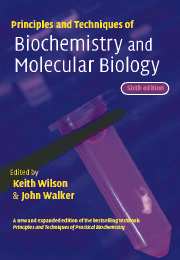Book contents
- Frontmatter
- Contents
- Preface to the sixth edition
- List of contributors
- List of abbreviations
- 1 Basic principles
- 2 Cell culture techniques
- 3 Centrifugation
- 4 Microscopy
- 5 Molecular biology, bioinformatics and basic techniques
- 6 Recombinant DNA and genetic analysis
- 7 Immunochemical techniques
- 8 Protein structure, purification, characterisation and function analysis
- 9 Mass spectrometric techniques
- 10 Electrophoretic techniques
- 11 Chromatographic techniques
- 12 Spectroscopic techniques: I Atomic and molecular electronic spectroscopy
- 13 Spectroscopic techniques: II Vibrational spectroscopy and electron and nuclear spin orientation in magnetic fields
- 14 Radioisotope techniques
- 15 Enzymes
- 16 Cell membrane receptors
- Index
- Plate sections
9 - Mass spectrometric techniques
Published online by Cambridge University Press: 05 June 2012
- Frontmatter
- Contents
- Preface to the sixth edition
- List of contributors
- List of abbreviations
- 1 Basic principles
- 2 Cell culture techniques
- 3 Centrifugation
- 4 Microscopy
- 5 Molecular biology, bioinformatics and basic techniques
- 6 Recombinant DNA and genetic analysis
- 7 Immunochemical techniques
- 8 Protein structure, purification, characterisation and function analysis
- 9 Mass spectrometric techniques
- 10 Electrophoretic techniques
- 11 Chromatographic techniques
- 12 Spectroscopic techniques: I Atomic and molecular electronic spectroscopy
- 13 Spectroscopic techniques: II Vibrational spectroscopy and electron and nuclear spin orientation in magnetic fields
- 14 Radioisotope techniques
- 15 Enzymes
- 16 Cell membrane receptors
- Index
- Plate sections
Summary
INTRODUCTION
General
Mass spectrometry (MS) is an extremely valuable analytical technique in which the molecules in a test sample are converted to gaseous ions that are subsequently separated in a mass spectrometer according to their mass-to-charge ratio (m/z) and detected. The mass spectrum is a plot of the (relative) abundance of the ions at each m/z ratio. Note that it is the mass to charge ratios of ions (m/z) and not the actual mass that is measured. If, for example, a biomolecule is ionised by the addition of one or more protons(H+) the instrument measures the m/z after addition of 1 Da for each proton if, the instrument is measuring positive ions or m/z minus 1 Da for each proton lost if it is measuring negative ions. The mass spectrum allows an accurate measure to be made of the relative molecular mass Mr(see Section 1.2.2 for details of this parameter) of each ionised molecule and in many cases details of its structure. The development of two ionisation techniques, electrospray ionisation (ESI) and matrix-assisted laser desorption/ionisation (MALDI) has enabled the accurate mass determination of high molecular mass compounds as well as low molecular mass molecules and has revolutionised the applicability of mass spectrometry to almost any biological molecule. Applications include the new science of proteomics (Section 8.5) as well as in drug discovery. The latter includes combinatorial chemistry, where a large number of similar molecules (combinatorial libraries) are produced and analysed to find the most effective compounds from a group of related organic chemicals. This chapter will cover the general principles of the technique and will concentrate on the applications of MS to protein structure.
- Type
- Chapter
- Information
- Principles and Techniques of Biochemistry and Molecular Biology , pp. 405 - 448Publisher: Cambridge University PressPrint publication year: 2005



